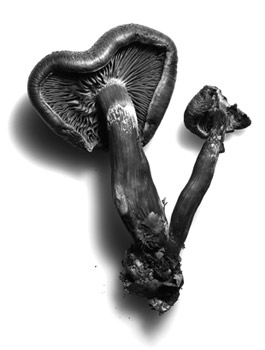Testing Gymnopilus luteofolius
Apr 22, 2020 (original Jun 2008)
Citation: Erowid. "Testing Gymnopilus luteofolius". Erowid Extracts. Jun 2008;14:2.

|
April 22, 2013 update to this article
At the December 2007 annual Fungus Fair held by the Mycological Society of San Francisco, volunteers brought in some nice dark rust-red samples of Gymnopilus luteofolius that they had collected in Marin County, California. These samples were positively identified as G. luteofolius by several mycologists in attendance. We received informal comments that it was a weakly active psilocybin-containing species of mushroom and the specimens seemed to show evident bluing.
A brief literature search showed that little analysis has been done of this species and we found no analysis of samples from the west coast of the United States. We received a recommendation for Central Valley Toxicology (CVT) as a laboratory that could do analytical testing of the mushroom to determine whether there was any psilocybin or psilocin present.
We submitted two small cuttings to CVT, one from the cap and one from the stem. Using methanol as the solvent, they tested the material with LC/MS (liquid chromatography/mass spectrometry). The lab reported that they found no detectable levels of psilocybin or psilocin in the Gymnopilus luteofolius samples and described their testing sensitivity as "down into the picogram level", meaning that they would have been able to detect psilocybin or psilocin even if the amount present was less than one billionth of a gram.
Based on these findings, we are able to say that the Northern California sample of Gymnopilus luteofolius was not psilocybin- or psilocin-containing.
Erowid Note - April 22, 2013: Experienced Gymnopilus luteofolius collectors in Northern California have repeatedly contacted us to let us know that they believe the negative finding in the analysis done by CVT described above is in error. Erowid will be reviewing the results and attempting to find additional specimens to have analyzed.
Update - April 22, 2020: Alan Rockefeller, a northern California mushroom expert, has added some additional details related to the identification and classification of the species of Gymnopilus that grow in the area where the sample described in this article was collected. In summary, rather than G. luteofolius, Rockefeller asserts that 'G. dilepis was almost certainly the species that was tested'. Please see Shroomery thread: Re: Active Gymnopilus luteofolius from California contains no Psilocybin, study shows, #26619186.


